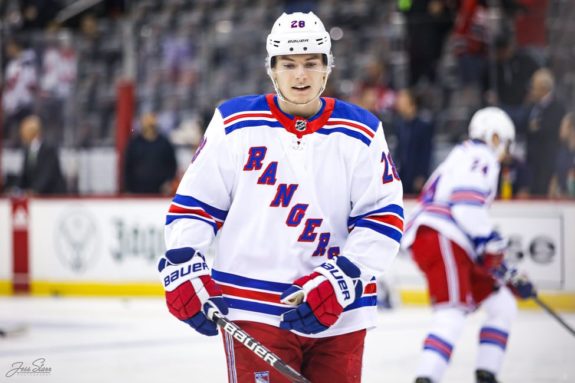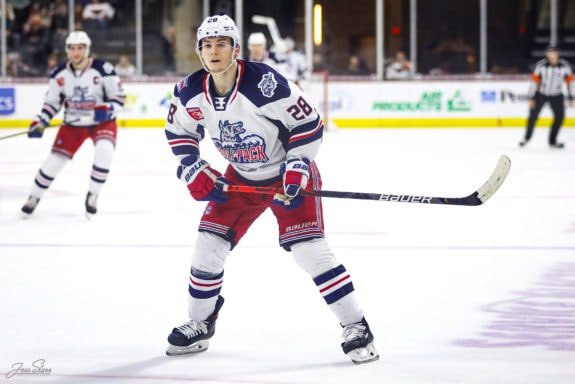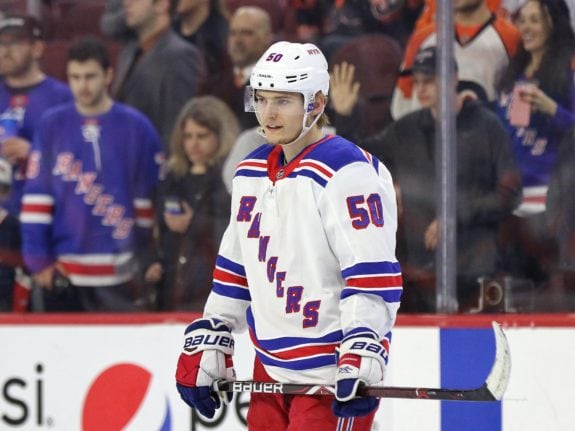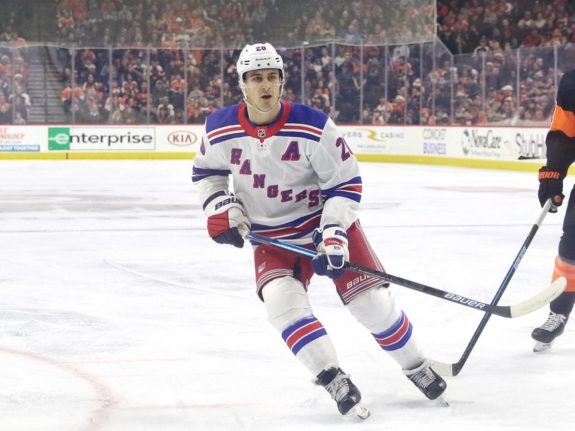Lias Andersson’s New York Rangers’ career has gotten off to a very rocky start, but he is just 21 years old and still has time to turn it around.
Andersson actually had a decent 2017-18 season after he was drafted seventh overall in the 2017 NHL Draft. He had seven goals and seven assists in 22 games with Frolunda HC, while playing in the Swedish Hockey League. He then went to the Hartford Wold Pack of the AHL and had five goals and nine assists in 25 games.

His play earned him an opportunity with the Rangers late in the season. He showed grit by blocking shots and throwing checks whenever he had the opportunity to do so. He also scored his first NHL goal and added an assist in seven games. The season ended and the future looked bright for Andersson, who was 19 years old at the time.
Andersson’s Struggles
Andersson began the following season back with the Wolf Pack but by early November earned another shot with the Rangers. This time, it didn’t go well.
His playing time was down and he spent most of his time on the fourth line. When he did play, he rarely showed the type of skill New York was expecting from such a high draft pick. He looked like a fourth-line player, and was a step behind everyone else.
Related: Henrik Lundqvist – By the Numbers for No. 30
He took some unnecessary penalties and at times looked unsure about what to with the puck, leading to giveaways. He also struggled with his coverage defensively. All of those issues are fairly common with young players but more alarmingly, he couldn’t produce at all offensively. His shot didn’t look very impressive and he did not demonstrate any playmaking ability. He did have one beautiful goal on a deke but other than that, failed to show his potential.

This season was more of the same for Andersson. He was sent back down to Hartford again after a slow start in New York but refused to play there and went to play in Sweden instead. Over the last two seasons, he has two goals, five assists and is minus-21 in 59 games with the Blueshirts.
What Went Wrong
When he was drafted many scouts thought Andersson didn’t have as a high a ceiling as most of the other top picks but thought his all-around play would make it less likely for him to be a bust. He has yet to show he is an NHL-caliber player, and this can be attributed to a few problems.
Andersson recently opened up about his struggles with anxiety and missing his home. He said returning to Sweden has helped him mentally. It’s easy to forget he’s a 21-year-old who had to adjust to life in a new country, thousands of miles from his home. Hopefully transitioning back to North America will be easier next time around since he’s already done it a few times now.

Andersson also didn’t look confident with the Rangers over the last two seasons and he wasn’t happy playing on the fourth line. Since returning to play in Sweden, he seems to be getting his confidence back and it has translated to increased production on the ice. He has seven goals and five assists in 15 games with HV71 Jonkoping in the Swedish Hockey League this season.
Andersson’s Attitude
I think Andersson’s biggest challenge will be his attitude moving forward. He has put a lot of the blame for his struggles on the way the Rangers have treated him.

He did not like being placed on the fourth line but the reality is his fellow fourth-liners Brett Howden, Phil Di Giuseppe and Greg McKegg have all played better than he has. The NHL is a performance-based league and Andersson’s performance in the NHL has been very disappointing thus far. Before he can expect to get more ice time with more skilled linemates, he will have to significantly improve his own play.
The Rangers have had plenty of young players who have played better than him and been shuffled back and forth between the AHL and the fourth line early in their careers.
Related: Worst Trades in NHL History
Ryan Callahan was better defensively and produced more than Andersson at both the NHL and AHL levels, only to be sent back to the AHL and benched repeatedly.
Chris Kreider scored five playoff goals for the Rangers in 2012 without ever playing in a regular-season game, only to be buried on the fourth line and benched the following season.

Filip Chytil, who like Andersson, was drafted in the first round of the 2017 NHL Draft, was sent to Hartford to start this season after he played all of last season with the Rangers. He didn’t complain, though, and produced nine points in nine games with Hartford. He then got called back up to New York and has taken advantage of the opportunity. He now has 14 goals in 60 games with the Blueshirts.
Andersson Can Resolve Each of These Problems
The good thing about Andersson’s problems is they can all be resolved. He’s already gone home and is dealing with the anxiety he had while in North America. He has been open about it and seems to have a strong support system around him. The most important thing is that instead of hiding it, he has reached out and gotten help. Being in a better place mentally will allow him to get back to enjoying playing hockey again.
The rest of his struggles can only be resolved by Andersson himself. It’s time for him to stop blaming the Rangers for his poor play. He may never become a big scorer but he can definitely still earn a spot on the team’s roster by improving in other areas of the game.

He has decent size and strength. He is an average skater but can still improve. Andersson has shown he isn’t afraid to hit and block shots but has been burned by poor defensive coverage and bad giveaways. If he commits to working on these problems, he should improve significantly and can become a very good, valuable defensive forward.
Related: Gretzky vs. Lemieux – Head to Head
It remains unclear how good Andersson can be offensively. He has shown a few flashes of offensive brilliance but he has yet to show consistency. Still, given his strength, just by going to the net he should be able to chip in offensively. He will also benefit from becoming more decisive offensively. Coaches can work with him on this.
Andersson’s career has not gotten off to an ideal start but he can quickly get back on track. He controls his own destiny. If he can commit to working on his flaws, he certainly has the potential to be a valuable NHL player.